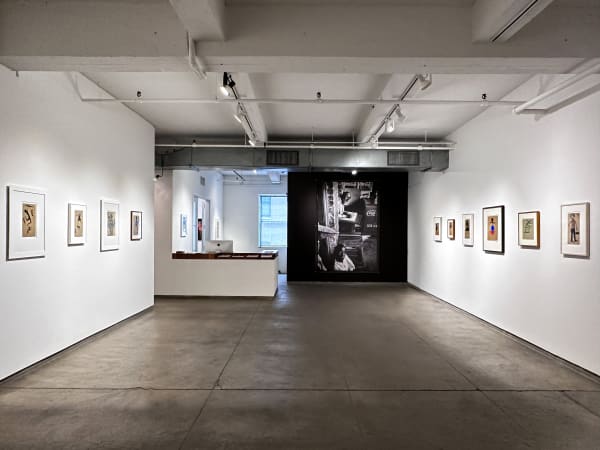Bill Traylor: Plain Sight: Gallery One
Ricco/Maresca’s history with Bill Traylor is almost as long as the gallery’s history itself. Our book Bill Traylor: His Art, His Life, the first volume devoted to the artist, was published by Alfred A. Knopf in 1991. Since then, we have mounted three one-person Traylor shows (in our Hudson Street, Wooster Street, and Chelsea spaces respectively), sold the first Traylor work acquired by the Museum of Modern Art in New York, built William Louis-Dreyfus’s Traylor collection (the best ever assembled), and published the catalog Bill Traylor: Observing Life (1997).
It is now our privilege to present Bill Traylor: Plain Sight. This exhibition is a touchstone in the gallery’s longstanding endeavor to earn the American self-taught master the recognition he has always deserved. Bill Traylor: Plain Sight follows more than 45 solo gallery and museum exhibitions, including the major retrospective Between Worlds: The Art of Bill Traylor, curated by Leslie Umberger at the Smithsonian American Art Museum (2018)—whose eponymous book is the most comprehensive scholarly publication on the artist’s life and work. Our exhibition celebrates the posthumous upward trajectory of Traylor’s work, which in the early 1980s could be acquired for an average market value of $1,500, and in 2020 reached an auction record of $507,000 for Man on White, Woman on Red / Man with Black.
***
Although emancipated as a boy, Bill Traylor continued to labor until around 1908 on a neighboring plantation to the Alabama plantation of John Getson Traylor in Dallas County, where he was born into slavery around 1853. It was only when he was in his eighties, and no longer able to do physical work, that he gravitated to the streets of Montgomery and started making art with materials that lay to hand. From 1939 to 1942, Traylor produced more than 1,200 drawings that are of crucial significance in American art and social history. Visitors to the segregated neighborhood of Montgomery, where Traylor moved in 1928, could have encountered him: a bearded old man sitting on a sidewalk on Monroe Street next to a Coca-Cola cooler—he drew all day and slept for free in the back of a funeral parlor. In 1939 Traylor caught the attention of a passerby named Charles Shannon, a young artist who was a member of the New South Art Center in Montgomery, along with a group of progressive white intellectuals. Shannon became Traylor’s friend and patron, safeguarding finished works and offering additional art supplies—though Traylor preferred to draw on salvaged cardboard. It was only around this time when the artist learned how to write his name, often practicing on the negative space around his drawings.
Traylor’s art expresses a gift for capturing the essence of the artist’s experience with a consummate economy of means. His formal solutions have the abstract, minimalist quality of archaic shapes—which some critics have associated with Carl Jung’s universal archetypes. Traylor’s imagery consists of laborers with hammers, drinkers with flasks, hunters with shotguns, dandies in hats, seniors with canes, rural pedestrians, and anthropomorphic figures often overlooked. People quarrel and point, live poultry flap wings, and frightening dogs go on the attack; characters hide beneath or stand atop and stumble off structures; there is a lot of apparent pursuit and escape. Many things may be inferred from this dynamic, but Traylor’s message is not necessarily knowable. His oeuvre, especially the more complex works referred to as “exciting events,” seems to depict imaginary scenarios frozen in time that combine direct observation with psychological depth.
Traylor’s practice was interrupted when he traveled to several northern cities between 1942 and 1945 to stay with a few of his children. After he lost a leg to gangrene, he returned to Montgomery 1946 to be with a long-lost daughter. He died three years later at Oak Street Hospital, a few days after summoning Shannon for a final visit.
Traylor’s early exhibitions include Bill Traylor: People’s Artist (organized by Shannon at the New South Art Center in 1940), a show at the Fieldston School in New York (1941), and one person gallery shows in New York, Chicago, and Philadelphia in the early 1980s. However, the public at large did not know Traylor’s work until it was included in the 1982 exhibition Black Folk Art in America 1930–1980 at the Corcoran Gallery of Art, in Washington, D.C. Today, his work is in important private and museum collections worldwide, including The Metropolitan Museum of Art, The Museum of Modern Art, and The Whitney Museum of American Art (New York), the Montgomery Museum of Fine Arts, the High Museum of Art (Atlanta), The Museum of Fine Arts (Houston), The Milwaukee Art Museum, The New Orleans Museum of Art, The Smithsonian American Art Museum (Washington, D.C.), and the Philadelphia Museum.
Click here to visit the online viewing room for this show and learn more about the works exhibited.






